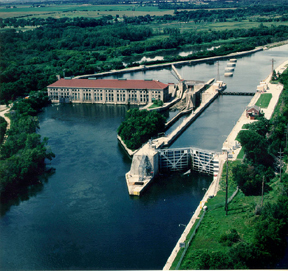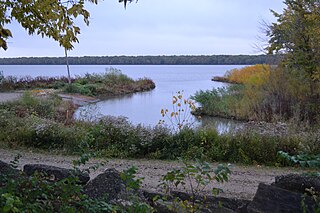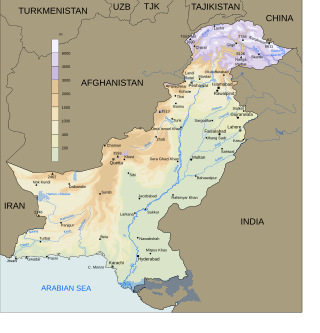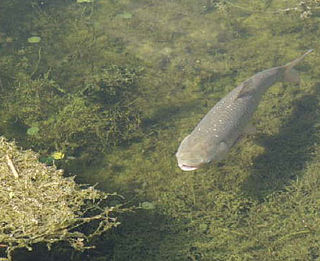Related Research Articles

The term carp is a generic common name for numerous species of freshwater fish from the family Cyprinidae, a very large clade of ray-finned fish mostly native to Eurasia. While carp are prized quarries and are valued as both food and ornamental fish in many parts of the Old World, they are considered trash fish and invasive pests in many parts of Africa, Australia and most of the United States.

The Eurasian carp or European carp, widely known as the common carp, is a widespread freshwater fish of eutrophic waters in lakes and large rivers in Europe and Asia. The native wild populations are considered vulnerable to extinction by the International Union for Conservation of Nature (IUCN), but the species has also been domesticated and introduced into environments worldwide, and is often considered a destructive invasive species, being included in the list of the world's 100 worst invasive species. It gives its name to the carp family, Cyprinidae.

The Illinois River is a principal tributary of the Mississippi River at approximately 273 miles (439 km) in length. Located in the U.S. state of Illinois, the river has a drainage basin of 28,756.6 square miles (74,479 km2). The Illinois River begins with the confluence of the Des Plaines and Kankakee rivers in the Chicago metropolitan area, and it generally flows to the southwest across Illinois, until it empties into the Mississippi near Grafton, Illinois. Its drainage basin extends into southeastern Wisconsin, northwestern Indiana, and a very small area of southwestern Michigan in addition to central Illinois. Along its shores are several river ports, including Peoria, Illinois. Historic and recreation areas on the river include Starved Rock, and the internationally important wetlands of the Emiquon Complex and Dixon Waterfowl Refuge.
Asian carp is a grouping of fishes commonly used to mean silver, bighead carp, white and black amur, which are regarded invasive in the United States. These four species, also known as copi, are native to China where they are collectively known as qing cao lian yong (青草鲢鳙) or si da jia yu and are farmed for food.

The black carp or Chinese black roach is a species of cyprinid freshwater fish and the sole extant species of the genus Mylopharyngodon. It is native to lakes and rivers in East Asia, ranging from the Amur Basin across China to Vietnam. One of the largest cyprinids in the world, the black carp has a typical length of 60–120 cm (23.5–47 in), though it can reach up to 1.9 m in length and 109 kg (240 lb) in weight. It is carnivorous and generally feeds on invertebrates such as snails, clams and mussels.

The Chicago Sanitary and Ship Canal, historically known as the Chicago Drainage Canal, is a 28-mile-long (45 km) canal system that connects the Chicago River to the Des Plaines River. It reverses the direction of the Main Stem and the South Branch of the Chicago River, which now flows out of Lake Michigan rather than into it. The related Calumet-Saganashkee Channel does the same for the Calumet River a short distance to the south, joining the Chicago canal about halfway along its route to the Des Plaines. The two provide the only navigation for ships between the Great Lakes Waterway and the Mississippi River system.

The bighead carp is a species of cyprinid freshwater fish native to East Asia, and is one of several Asian carps introduced into North America. It is one of the most intensively exploited fishes in fish farming, with an annual worldwide production of over three million tonnes in 2013, principally from China. Unlike the omnivorous common carp, bighead carp are primarily filter-feeding algae eaters, preferentially consuming zooplankton but also phytoplankton and detritus.

The silver carp or silverfin is a species of freshwater cyprinid fish, a variety of Asian carp native to China and eastern Siberia, from the Amur River drainage in the north to the Xi Jiang River drainage in the south. Although a threatened species in its natural habitat, it has long been cultivated in China as one of the "Four Famous Domestic Fish" (四大家鱼) together with Bighead carp, Black carp and Grass carp. By weight, more silver carp are produced worldwide in aquaculture than any other species of fish except for the grass carp. Silver carp are usually farmed in polyculture with other Asian carp, or sometimes with catla or other fish species.

Des Plaines Fish and Wildlife Area is an Illinois state park on 5,000 acres (2,023 ha) in Will County, Illinois, United States. It is located on floodplain adjacent to the confluence of the Des Plaines River and the Kankakee River to form the Illinois River.

Marshall State Fish and Wildlife Area is an Illinois state park on 6,000 acres (2,400 ha) in Marshall County, Illinois, United States.

There are two major sources of fish in Uganda; one is from aquaculture, the other from fishing in rivers and lakes. The latter has made up the largest and most significant share of all fishing. Open water covers 15.3 percent of Uganda's surface and comprises five major lakes which are the main sources of fish in the country. Lake Victoria continues to be the most important water body in Uganda both in size and contribution to the total fish catch, followed by Lake Albert and Lake Kyoga.

A hand net, also called a scoop net, is a handheld fishing net or meshed basket used to capture and retrieve objects from water, somewhat in the manner of a sieve. It is distinguished from other fishing nets in that the net or mesh is supported by a rigid circular or polygonal frame, which may or may not be mounted to the end of a handle.

China has one-fifth of the world's population and accounts for one-third of the world's reported fish production as well as two-thirds of the world's reported aquaculture production. It is also a major importer of seafood and the country's seafood market is estimated to grow to a market size worth US$53.5 Billion by 2027.

Carp is a common name for various species of freshwater fish from the family Cyprinidae that are native to Eurasia and sought after by some recreational fishermen. Certain carp species have been introduced, with mixed results, to various other locations around the world, and even declared invasive in certain regions.

China, with one-fifth of the world's population, accounts for two-thirds of the world's reported aquaculture production.

The fishing industry plays a significant part in the national economy of Pakistan. With a coastline of about 1,120 km, Pakistan has enough fishery resources that remain to be developed. Most of the population of the coastal areas of Sindh and Balochistan depends on fisheries for livelihood. It is also a major source of export earning.

The harvesting and consuming of seafoods are ancient practices that may date back to at least the Upper Paleolithic period which dates to between 50,000 and 10,000 years ago. Isotopic analysis of the skeletal remains of Tianyuan man, a 40,000-year-old modern human from eastern Asia, has shown that he regularly consumed freshwater fish. Archaeology features such as shell middens, discarded fish bones and cave paintings show that sea foods were important for survival and consumed in significant quantities. During this period, most people lived a hunter-gatherer lifestyle and were, of necessity, constantly on the move. However, where there are early examples of permanent settlements such as those at Lepenski Vir, they are almost always associated with fishing as a major source of food.

Fish are an important motif in Chinese mythology. There are various myths involving fish. Chinese mythology refers to those myths found in the historical geographic area of China. The geographic area of "China" is of course a concept which has evolved of changed through history. Fish in Chinese mythology include myths in Chinese and other languages, as transmitted by Han Chinese as well as other officially recognized 56 minority ethnic groups in China. The Chinese word for "fish", yu, is a homophone for "abundance", "plenty", and "affluence" ; therefore, fishes are a symbol of wealth. The Chinese dragon is the head of the fish clan. The act of fishing is also an important motif in Chinese mythology and culture.

Asian carp, a group of invasive species of fish introduced into North America, pose a major threat to the ecology, environment, economy, and way of life in the Upper Midwest and Great Lakes region of the United States and Canada. The term refers to a group of cyprinid fish species originally native to East Asia, of which include several are known to be invasive in the United States, and represent the most urgent potential danger to the ecology of the Great Lakes.

Powerton Lake State Fish and Wildlife Area is a 1,426-acre (577 ha) area of semi-protected habitat on the Illinois River southwest of to the city of Pekin, Illinois within Tazewell County in the U.S. state of Illinois. The parcel is a cooling reservoir owned by NRG Energy, an electric power generating firm, and is operated by the Illinois Department of Natural Resources (IDNR). The lake is used for fishing, with an emphasis on blue catfish. In addition, IDNR states that approximately 60% of the cooling pond is used for duck and goose hunting during legal hunting seasons. The remaining 40% of the pond is maintained as a waterfowl refuge on a year-round basis.
References
- ↑ Hustis, Sam (2015-09-06). "Redneck Fishing Tournament Celebrates 10th Anniversary". CENTRALILLINOISPROUD. Retrieved 2018-08-10.
- ↑ "The Original Redneck Fishing Tournament - Bath, IL" . Retrieved 2018-08-10.
- ↑ Network, World Fishing (2013-10-30). "Fishing Central WFJ Episode 1, Part 3: The Redneck Fishing Tournament - World Fishing Network". World Fishing Network. Retrieved 2018-08-10.
- ↑ Garcia, Evan. "'Redneck Fishing' for Flying Asian Carp on the Illinois River". WTTW. Retrieved 2018-08-10.
- ↑ Walsh, Bryan. "Lake Invaders". Time. Time. Retrieved 2018-08-10.
- ↑ "Redneck Fishing Tournament - Visit Canton, IL". www.visitcantonil.org. Retrieved 2018-08-10.
- ↑ "Carp Attack". National Wildlife Federation. Retrieved 2018-08-10.
- ↑ "Talking about climate change at 'redneck' fishing tournament". Planet Forward. Retrieved 2018-08-10.
- ↑ Heffernan, Erin. "How do you fight flying fish? With a net and a hockey helmet, of course". stltoday.com. Retrieved 2018-08-10.
- ↑ Cather, Johnny. ""Redneck Fishing Tournament" Aims to Stop Invasive Asian Carp" . Retrieved 2018-08-10.
- ↑ "Original Redneck Fishin' Tournament Rules and Information" . Retrieved 2018-08-10.
- ↑ "The Original Redneck Fishing Tournament - Bath, IL | About". The Original Redneck Fishing Tournament - Bath, IL. Retrieved 2018-08-10.
- ↑ "PROTECTING THE GREAT LAKES – BIOLOGISTS TURN OUT FOR ASIAN CARP-CATCHING TOURNAMENT – Climate Change". climatechange.medill.northwestern.edu. Retrieved 2018-08-10.
- ↑ Heffernan, Erin. "How do you fight flying fish? With a net and a hockey helmet, of course". stltoday.com. Retrieved 2018-08-10.
- ↑ "Illinois "Redneck fishing tournament" uses nets, helmets". WQAD.com. 2018-08-06. Retrieved 2018-08-10.
- ↑ Cather, Johnny. ""Redneck Fishing Tournament" Aims to Stop Invasive Asian Carp" . Retrieved 2018-08-10.
- ↑ "'Redneck Fishing' for Flying Asian Carp on the Illinois River". Chicago Tonight | WTTW. Retrieved 2018-08-10.
- ↑ "Near historic flooding has cancelled the annual Redneck Fishing Tournament". KMOX-AM. 2019-07-05. Retrieved 2019-07-05.
- ↑ "Watch: Redneck fishing tournament returns to the Illinois River". NBC News. Retrieved 2023-02-19.